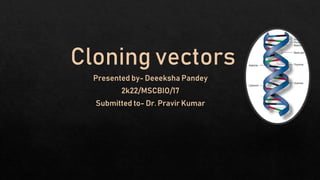
Cloning vectors.pptx
- 3. Scientists (Herbert Boyer,Keiichi Itakura and Arthur Riggs) working in Hoyer's lab (Universityof California, San Francisco) recognized a general cloning vector with unique restriction sites for cloning in foreign DNA and the expressionof antibiotic resistance genes for selection of transformed bacteria. In 1977, they described the first vector designed for cloning purposes,pBR322-a plasmid. The p stands for "plasmid," andBR for "Bolivar" and "Rodriguez.“ This vector was small,-4 kb in size, and had two antibiotic resistance genes for selection.
- 12. Plasmid- • Plasmid is an autonomously replicating circular double stranded extra- chromosomal DNA which is physically separated from a chromosomal DNA and can replicate independently. • They are most commonly found in bacteria, sometimes they are present in archaca and eukaryotic organisms. • The size of the plasmid varies from 1 to over 200 kb. Most general plasmids may be used to clone DNA insert of up to 10 kb in size. • Many plasmids have high copy number and high copy number is useful as it produces greater yield of recombinant plasmid for subsequent manipulation However low copy number plasmids may be preferably used in certain circumstances, for example, when the protein from the cloned gene is toxic to the cells. • • Example: pBR322, pUC18, F plasmid, Col Plasmid etc. Bacteriophage- • The bacteriophages used for cloning are the phage 2 and M13 phage. • There is an upper limit on the amount of DNA that can be packed into a phage (a maximum of 53 kb). • There is also a lower size limit for DNA that can be packed into a phage, and vector DNA that is too small cannot be properly packaged into the phage.
- 13. Cosmid- • They combine features of both plasmid and lambda phage. Their plasmid part enables them to replicate as it has origin of replication. • Plasmid part also help in selection due to presence of marker gene. • Their lambda part (cos sequence)allow them to be packaged in a phage coat and to be transduce to a recipient by the lambda infection machinery. • It has no genes for viral protein, there fore viral particle are not formed in host. • Host cell lysis are also absent. Bacterial Artificial Chromosome(BAC)- • BAC vectors are similar to standard E. coli plasmid vectors. • Contain the origin and genes encoding the ori binding proteins required for plasmid replication. • Derived from a naturally occurring large plasmid, the F' plasmid. Low copy number (1-2 copies per cell) • The bacterial artificial chromosome's usual insert size is 150-350 kb. • BACS are preferred for different kind of genetic studies of inherited infectious diseases because they accommodate much larger sequence without the risk of rearrangement, and are therefore more stable than other types of cloning vectors.
- 14. Yeast Artificial Chromosome (YAC) • First described in 1983 by Murray and Szostak. • Yeast artificial chromosomes is a human engineered DNA molecule used to clone DNA sequences in yeast cells. • YACS are shuttle vectors capable of replicating and being selected in common bacterial hosts such as E.coli as well as in the yeast S. cerevisiae. • They are capable of carrying approximately up to 1000 kbp of inserted DNA sequence. Many different YAC plasmids exist, such as pYAC3 & PYAC4. Human Artificial Chromosome- • A human artificial chromosome (HAC) is a micro chromosomethat can act as a new chromosomein a population of human cells. • That is, instead of 46 chromosomes, the cell could have 47 with the 47th being very small, roughly 6-10 mega bases (Mb) in size instead of 50-250 Mb for natural chromosomes, and able to carry new genes introduced by human researchers. • Ideally, researchers could integrate different genes that perform a variety of functions, including disease defense.
- 15. Retro virus- • Consists of pro viral sequences that can accommodate the gene of interest, to allow incorporation of both into the target cells. • The vector also contains viral and cellular gene promoters, such as the CMV promoter, to enhance expression of the gene of interest in the target cells